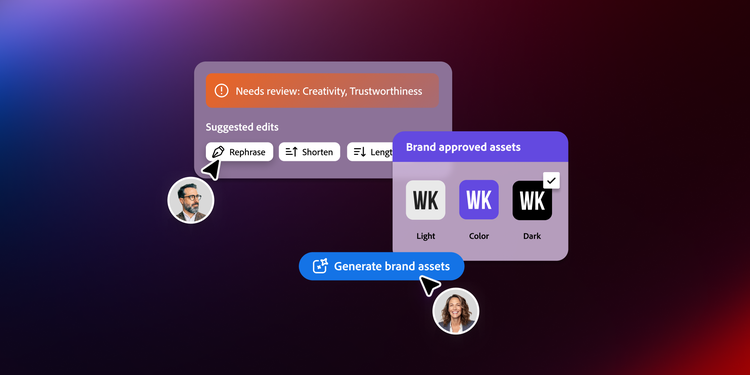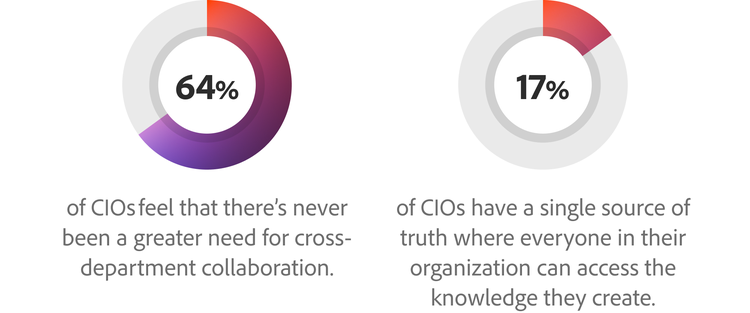The CIO’s guide to leveraging AI to get more out of your IT and marketing dollars

When I talk with my fellow chief information officers (CIOs), one theme that comes up frequently is that most of our organizations already have the resources to meet our business goals, but these resources are far too often locked up in silos or inefficient processes. Our marketing colleagues tell us they often wrestle with the same challenges. While inefficiencies are never healthy for business, their impacts are being magnified by uncertain economic times, when virtually every company is seeking to do more with less. Thankfully, recent advances in generative AI technology are giving CIOs, chief digital officers (CDOs) and chief marketing officers (CMOs) new opportunities to drive greater operational efficiencies by bridging the divide between IT and marketing teams.
During the last year, generative AI technologies have evolved from experimental to genuinely exciting and commercially viable, setting the stage for revolutionary changes to the ways marketers work. Yet, while companies of all sizes want to deploy generative AI sooner rather than later, many business leaders — including those in marketing — tell us they’re still working through a variety of practical implementation questions. Their top concerns include the growing number of one-off tools, the safety of rolling out new capabilities across large-scale workforces, ethical considerations, data confidentiality, and reskilling workers.
Collaboration and communication are key
As CIO of Adobe, I have firsthand experience rolling out AI tools across a large organization. I’ve seen how generative AI can play a critical role in bridging the divide between IT, digital, and marketing organizations. In enterprises across sectors, CIOs like myself are CMOs’ key AI implementation partners for adapting these technologies into workstreams that enrich employee experiences, enhancing employee productivity while reducing mundane activities and enabling their companies to unleash the full potential of their resources. They help marketers who have been limited by their own team’s resources and reliant upon specialized campaign management tools. The latest generative AI-assisted tools are parts of larger integrated solutions that CIOs can implement across multiple teams, connecting marketers and creatives, simplifying collaboration and reviews, and empowering more people to become productive, faster.
By collaborating with CMOs from the very beginning, CIOs can identify the problems AI needs to address — what exactly needs to be automated and which solutions will actually work for the creative and marketing teams who will be using them every day. This also helps marketers stay true to their brands, as CIOs can set them up for success, ensuring these new technologies are deployed in ways that are safe, ethical, and forward-thinking, while also supporting employees’ career growth.
Here are four ways CIOs can work with CMOs to thoughtfully select and deploy generative AI:
-
Identify initial use cases, then test small before a large rollout. Even within tightly knit organizations, individual teams may have their own priorities for saving time with generative AI tools. CIOs should start by working with teams to identify the areas of opportunity generative AI could bolster then pilot tools that enable teams to multiply their capabilities.
At Adobe, we believe that great ideas come from anywhere in the company, and that our employees have the strongest pulse on what our business, employees, and customers need to be successful. For those reasons, we often host hackathons to develop innovative solutions to address issues and opportunities. Recently we’ve focused these hackathons on solutions powered by generative AI that will drive efficiencies, allowing our teams to do more with less. Our hackathons create a secure sandbox for teams to experiment safely and responsibly with test data. We then adopt the winning solutions across our enterprise. -
Consider generative AI ethics early and often. Trust is a key factor in generative AI deployment; ethical solutions produce results that businesses can be deploy with confidence. It’s important to have transparency not only on how AI tools are trained, but also in how they can be adapted to best support your audience. Especially in today’s “wild west” of generative AI development, brands now depend on CIOs to carefully select solutions that are ethically developed, commercially safe, and protective of IP rights.
To continue earning trust, every organization and its AI technology vendors must make firm commitments and clear disclosures regarding where and how AI is being developed and deployed. Moreover, internal review processes must be in place to ensure generative AI tool outputs are consistently meeting both brand standards and customer expectations, including conspicuous disclosures of AI use where appropriate. -
Rather than one-off tools, look for unified solutions that connect with your marketers’ workflows. Brands across the world know that the typical content creation-to-activation cycle to deliver a web page or marketing campaign demands weeks of time and extensive manual handoffs — long processes including brief writing, creative ideation, collaboration and review, production, channel activation, content, re-versioning, and analytics and reporting.
According to Adobe research, 64 percent of CIOs feel that there’s never been a greater need for cross-department collaboration, yet only 17 percent have a single source of truth where everyone in their organization can access the knowledge they create. Unified solutions address both of these challenges.

At Adobe, we weave generative AI and smart automation into our content supply chain — the people and processes that plan, produce, deliver, and analyze content — empowering teams to work in real time to collaborate on creative ideas and decisions to deliver personalization at scale, turning ideation, edits, and versioning cycles into minutes instead of hours and days. New generative AI technologies can even summarize and analyze information, then answer questions and produce everything from documents to presentations, saving significant time, and resources.
- Don’t just deploy generative AI; upskill and train workers to use it. Generative AI is a new frontier, and the technology continues to advance at a rapid pace. Like most other tools, generative AI works best when people learn how to get the most from it. Although relatively few people have learned its nuances, others are learning to use the latest tools as fast as they can. At this stage, companies need to train employees on prompt engineering and educate them about the technology so they can learn what questions to ask.
CIOs strive to equip people with tools that enable them to work smarter. It’s clear that organizations that adopt generative AI will be the ones that win moving forward. Thus, it’s important for employees both to have access to generative AI tools and to learn how to use them. Companies that support and prioritize their workers’ generative AI-related professional development and investment are the ones that will rise above the rest.
History has shown that when workflows and internal processes are fully digitized, employees don’t just become more efficient, they become more engaged and enjoy higher morale, as they can spend more time on higher-value work, learn new skills, and progress in their careers. Positive employee energy ultimately translates into better customer experiences.
Generative AI will unlock employees’ full potential
At Adobe, we’ve found that bridging IT and marketing requires teams to work together to deploy generative AI technologies: CIOs and CDOs are responsible for implementing the technology, then getting teams up and running. At that point, the CMOs and their marketers put it to use in the trenches. To truly empower employees, CIOs should communicate early, map out and test potential use cases, adopt unified, ethically developed technologies, and teach people how to use them. That’s how we’ve unlocked their full potential at Adobe and how you can do the same in your own business to deliver the next generation of amazing marketing.